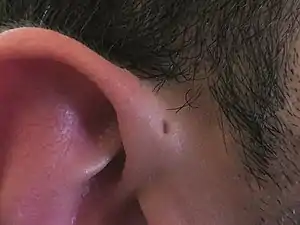Preauricular sinus and cyst
Preauricular sinuses and preauricular cysts are two common congenital malformations. Each involves the external ear. The difference between them is that a cyst does not connect with the skin, but a sinus does. [3] Frequency of preauricular sinus differs depending the population: 0.1–0.9% in the US, 0.9% in the UK, and 4–10% in Asia and parts of Africa.[4]
| Preauricular sinus and cyst | |
|---|---|
| Other names | Congenital auricular fistula, Congenital preauricular fistula, Ear pit,[1]: 782 or a Preauricular cyst[2] |
 | |
| Preauricular sinus on right ear | |
| Specialty | Otorhinolaryngology |
Preauricular sinuses are inherited features, and frequently appear next to both ears.[5] Preauricular sinuses can be associated with other defects that are not visible, one example being branchio-oto-renal syndrome.[6]
Presentation
Causes
Preauricular sinuses and cysts result from developmental defects of the first and second pharyngeal arches.[10] This and other ear malformations are sometimes associated with renal anomalies.[11] In rare circumstances these pits may be seen in genetic conditions such as branchio-oto-renal syndrome; however these conditions are always concurrent with other health concerns.[12]
Treatment
Courses of treatment typically include the following:
- Surgical excision is indicated with recurrent fistular infections,[13] preferably after significant healing of the infection. In case of a persistent infection, infection drainage is performed during the excision operation. The operation is generally performed by an appropriately trained specialist surgeon e.g. an otolaryngologist or a specialist General Surgeon.
- The fistula can be excised as a cosmetic operation even though no infection appeared. The procedure is considered an elective operation in the absence of any associated complications.
See also
References
- Freedberg IM, Fitzpatrick TB (2003). Fitzpatrick's Dermatology in General Medicine (6th ed.). McGraw-Hill. ISBN 978-0-07-138076-8.
- Rapini RP, Bolognia JL, Jorizzo JL (2007). Dermatology: 2-Volume Set. St. Louis: Mosby. ISBN 978-1-4160-2999-1.
- Thatcher, A.L. (2022). Congenital and inflammatory neck masses in children. In M. Lesperance (Ed.), Cummings Pediatric Otolaryngology, 23, 308-321.
- Kim HJ, Lee JH, Cho HS, Moon IS (September 2012). "A case of bilateral postauricular sinuses". Korean Journal of Audiology. 16 (2): 99–101. doi:10.7874/kja.2012.16.2.99. PMC 3936561. PMID 24653881.
- Moore, K.L., Persaud, T.V.N., & Torchia, M.G. (2010). Development of eyes and ears. Before we are born, 17, 257-268.e1.
- MedlinePlus Genetics [Internet] (18 August 2020). "Branchiootorenal/branchiootic syndrome". MedlinePlus. Retrieved 16 March 2022.
- James WD, Berger TG, et al. (2006). Andrews' Diseases of the Skin: Clinical Dermatology. Saunders Elsevier. ISBN 978-0-7216-2921-6.
- Ludwig S, Strobel S, Marks SD, Smith PK, El Habbal MH, Spitz L (2008). Visual Handbook of Pediatrics and Child Health. Lippincott Williams & Wilkins. p. 517. ISBN 978-0-7817-9505-0.
- Leopardi G, Chiarella G, Conti S, Cassandro E (December 2008). "Surgical treatment of recurring preauricular sinus: supra-auricular approach". Acta Otorhinolaryngologica Italica. 28 (6): 302–5. PMC 2689545. PMID 19205595.
- "Preauricular Sinus". Stedman's Medical Spellchecker. 2006. Retrieved 24 Feb 2009.
cited in WrongDiagnosis.com
- Wang RY, Earl DL, Ruder RO, Graham JM (August 2001). "Syndromic ear anomalies and renal ultrasounds". Pediatrics. 108 (2): E32. doi:10.1542/peds.108.2.e32. PMID 11483842.
- "Branchiootorenal syndrome". Genetic and Rare Diseases Information Center (GARD). Archived from the original on 2018-07-05. Retrieved 2018-07-05.
- Dellinger, M.B., & Waldhausen, J.H.T. (2020). Head and neck sinuses and masses. In Holcomb and Ashcraft's Pediatric Surgery, 72, 1171-1185.
Bibliography
- Leopardi G, Chiarella G, Conti S, Cassandro E (December 2008). "Surgical treatment of recurring preauricular sinus: supra-auricular approach". Acta Otorhinolaryngologica Italica. 28 (6): 302–5. PMC 2689545. PMID 19205595.
- Kim JR, Kim DH, Kong SK, Gu PM, Hong TU, Kim BJ, Heo KW (November 2014). "Congenital periauricular fistulas: possible variants of the preauricular sinus". International Journal of Pediatric Otorhinolaryngology. 78 (11): 1843–8. doi:10.1016/j.ijporl.2014.08.005. PMID 25190621.
Further reading
- Tan T, Constantinides H, Mitchell TE (November 2005). "The preauricular sinus: A review of its aetiology, clinical presentation and management". International Journal of Pediatric Otorhinolaryngology. 69 (11): 1469–74. doi:10.1016/j.ijporl.2005.07.008. PMID 16125253.